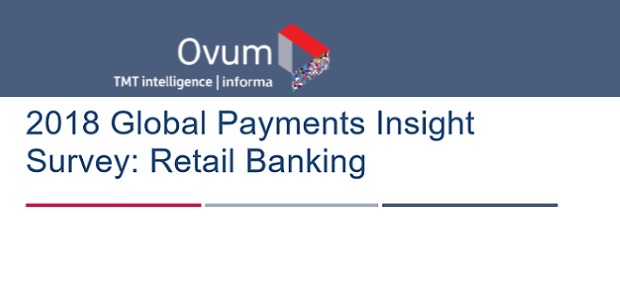
New benchmark study from ACI Worldwide and Ovum reveals both real-time payments and open banking as major competitive differentiators in the future of banking. Banks are increasingly optimistic about open banking opportunities, with 87% reporting a clear strategy for Open APIs– a dramatic increase from 2017. 68% of banks are enhancing online payments capabilities like tokenization, while real-time payments drive a new wave of payment hub investment for 43% of respondents.
As open banking continues its rapid ascent, nearly 90 percent (87) of banks globally plan to move forward with open APIs, according to new benchmark data, “2018 Global Payments Insight Survey: Retail Banking,” from ACI Worldwide (NASDAQ: ACIW) and Ovum. The benchmark, comprised of responses from executives across financial institutions, merchants and billing organizations such as consumer finance and insurance, also showed that the emphasis on real-time payments has doubled from 31 percent to 62 percent within a 12-month span.
The explosion of activity in real-time payments and open banking has made payments transformation a key strategic initiative for many institutions globally. Although driven primarily by regulatory mandates in Europe, open banking has taken off in North America due to market competition. For banks, the message is clear; customers prefer real-time payments, whether it’s through a mobile app, or through traditional banking services.
Other findings from the study include:
Open Banking
. Banks reporting a clear strategy for developing APIs increased by 47 percent within one year
. European banks led at 92 percent, followed by 86 percent in Asia, and 82 percent in the Americas
. Over 70 percent (73) of banks were willing to open up their APIs to third party developers
. At 79 percent, European banks had the most proactive mindset, followed by Asia at 74 percent, and the Americas at 66 percent; interestingly, 70 percent of banks in the U.S. plan to encourage the use of their APIs
Real-Time Payments
. Banks that now expect real-time payments to drive revenue growth increased by 60 percent in one year
. The number of banks currently investing in real-time payments solutions doubled in a year, with 28 percent planning to make future investments
. Real-time payments drive a new wave of real-time payment hub investment for 43 percent of respondents
Online payment capabilities
Holding steady at 68 percent globally are banks that currently or recently invested in this area, with many enhancing support for third-party wallet offerings and tokenization
Payment Cards
. Real-time is becoming a reality with nearly 80 percent (78) of banks and almost 70 percent (68) of merchants globally stating that the combination of immediate payments and open banking will drive a decline in the importance of payment cards
Security/Compliance
. As banks prepare for the new payments ecosystem, they’re looking to balance security and compliance alongside innovation
. Security is a chief area of concern around open banking, increasing in Europe by 29 percent, and Asia by 16 percent between 2017 and 2018. However, banks in the Americas with security concerns declined by 25 percent
“The dramatic change in attitudes toward both open banking and real-time payments in just one year is telling,” said Craig Ramsey, head of real-time payments, ACI Worldwide. “The big takeaway here is that real-time payments and open banking are set to reshape the competitive landscape, and banks should stay open to the potential new revenue streams and deepened relationships that will be brought to both consumers and merchants.”
“The results of the study highlight important steps that all retail banks should consider to ensure that they are prepared for current challenges and future opportunities,” said Kieran Hines, head of industries, Ovum. “Real-time payments and open banking initiatives have the potential to bring fundamental change to the retail banking value chain and must be viewed as true opportunities for service enhancement and transformation.”
Read the full report: Real-time and Open APIs Drive Payments Transformation
Methodology:
For the 2018 Global Payment Information Survey, Ovum and ACI Worldwide partnered to run a 22-question survey across a global panel of executives, with a focus on retail banks, billing organizations and merchants. The main topics of focus for the survey include: IT investment plans around payment services, core business objectives and priorities, attitudes toward fraud and security, payment systems and architecture, and plans and experiences around open banking and real-time payments.
The survey was conducted between December 2017 and January 2018 and provides insight into current thinking in the industry across financial institutions, merchants and billing organizations such as higher education, consumer finance and insurance. Overall, it included a total of 1,032 executive respondents across 13 industry sub verticals in 19 countries, resulting in 225,000 separate data points on current perceptions and investment plans around payments technology on a global basis.
This paper focuses on the survey findings for retail banks and is one of a four-part series based on Ovum’s 2018 survey.
Source: ACI Worldwide
Banking 4.0 – „how was the experience for you”
„To be honest I think that Sinaia, your conference, is much better then Davos.”
Many more interesting quotes in the video below: